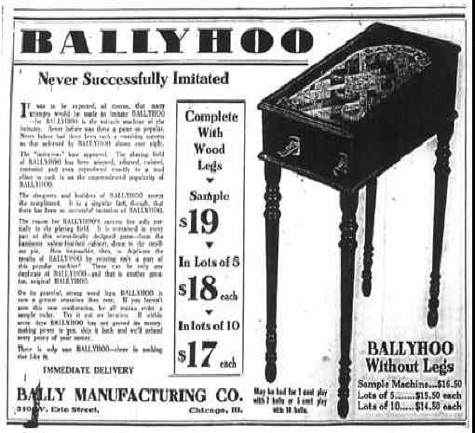History of Pinball Machines
Explore the evolution of pinball machines from their inception to modern-day designs.


The Evolution of Pinball Machines
Pinball machines have captivated players for generations, evolving from simple mechanical devices into complex, high-tech gaming experiences. This blog post explores the rich history of pinball, tracing its development from the 18th-century game of bagatelle to the sophisticated machines of today. We will delve into key innovations, influential games, and the cultural significance of pinball throughout the decades.
The Origins: Bagatelle and Early Games
The roots of pinball can be traced back to bagatelle, a game that emerged in France during the 18th century. Bagatelle involved rolling balls into holes at the bottom of a sloped board filled with pins. Players used a stick or plunger to launch the balls, aiming for scoring pockets. This early version of pinball laid the groundwork for future developments in the genre.
By the 19th century, bagatelle evolved into more recognizable forms of pinball. The first mechanical pinball machines appeared, featuring spring-loaded plungers that launched balls onto a playing field. These early machines lacked flippers and relied heavily on gravity and player skill to keep the ball in play
The Birth of Coin-Operated Pinball
The first coin-operated pinball machine was invented in 1931 by Automatic Industries and was known as the Whiffle Board. This marked a significant shift in how people interacted with pinball, as it introduced a pay-to-play model that would become standard in arcades. The Whiffle Board featured wooden legs and basic gameplay mechanics, setting the stage for future innovations.
The Flipper Revolution
A pivotal moment in pinball history occurred in 1947 when Gottlieb released Humpty Dumpty, the first pinball machine to feature flippers. This innovation transformed gameplay by allowing players to control the ball’s movement more effectively, leading to a more strategic gaming experience. The introduction of flippers is often credited with revitalizing interest in pinball following World War II.
The Electro-Mechanical Era
The 1960s saw further advancements with the introduction of electro-mechanical (EM) machines. These machines utilized relays and score reels instead of mechanical components, allowing for more intricate gameplay mechanics and improved reliability. Notable EM games from this era include Williams’ Space Odyssey (1976), which showcased advanced features like multiple scoring options and complex playfields.
The Solid-State Revolution
The solid-state era marked a significant turning point for pinball machines. With advancements in microprocessor technology, manufacturers could create games with intricate rulesets, multiple levels, and immersive themes. Williams dominated this period with iconic titles such as Black Knight (1980), which featured a multi-level playfield and innovative gameplay mechanics.
One of the most successful pinball machines ever produced was The Addams Family, designed by Pat Lawlor and released in 1992. It sold over 20,000 units and set new standards for gameplay complexity and design quality. Following this success, Lawlor created other beloved titles like Twilight Zone (1993) and Medieval Madness (1997), which are still highly sought after by collectors today
The Decline of Pinball
Despite its popularity during the 1980s and 1990s, pinball faced significant challenges with the rise of video games like Pac-Man and Space Invaders. As arcade culture shifted towards digital gaming experiences, many traditional pinball manufacturers struggled to adapt to changing consumer preferences.By the late 1990s and early 2000s, several companies went out of business, leading to a decline in pinball machine production.
During this period, many arcade venues began removing pinball machines from their floors due to decreased demand. However, dedicated enthusiasts continued to preserve classic machines through private collections and home setups
The Resurgence of Pinball
In recent years, pinball has experienced a remarkable resurgence driven by passionate enthusiasts and new manufacturers entering the market. Companies like Jersey Jack Pinball and Spooky Pinball have emerged, producing innovative machines that combine traditional gameplay with modern technology.
Modern Innovations
Today’s pinball machines are marvels of engineering that incorporate advanced technologies previously unimaginable. Many modern designs feature:
- Interactive Displays: High-definition screens provide dynamic animations and game information.
- Innovative Gameplay Mechanics: Features like magnetic flippers or interactive toys enhance engagement.
- Customizable Settings: Players can adjust difficulty levels or game rules to suit their preferences.
These advancements have attracted a new generation of players while rekindling interest among long-time fans
Cultural Impact
Pinball has left an indelible mark on popular culture since its inception. From appearances in films like The Wizard (1989) to references in music and television shows, pinball has become synonymous with arcade culture. Its nostalgic appeal continues to resonate with players who fondly remember their experiences at local arcades or bars.Moreover, events such as the annual Pinball Expo bring together enthusiasts from around the world to celebrate their shared passion for this unique form of entertainment.
Conclusion
The history of pinball machines is a testament to human creativity and innovation. From humble beginnings as bagatelle tables to high-tech gaming experiences enjoyed by millions today, pinball has evolved significantly over time. As we look forward to future developments in this beloved pastime, one thing remains clear: pinball will continue to captivate players for generations to come. This blog post provides an extensive overview of the history of pinball machines while highlighting key innovations that have shaped their evolution over time.
